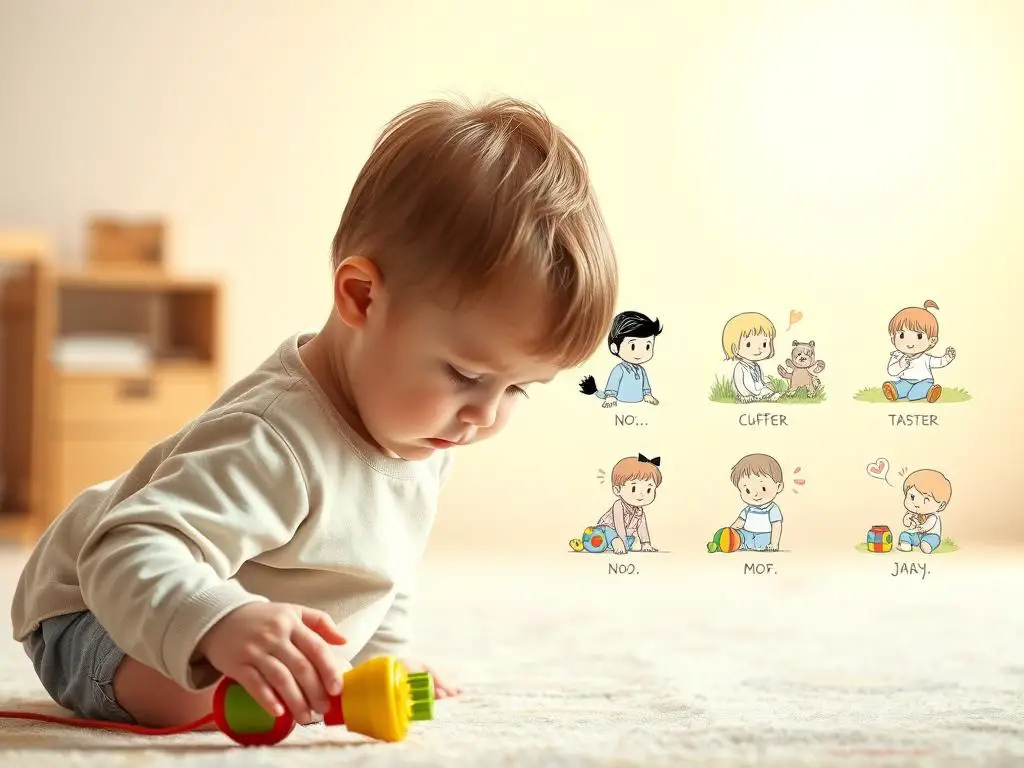Does it seem like your little one has found the most powerful word in English? They use it for everything. You’re not alone in this daily battle of wills.
When your child rejects every request, it can be really tough. This phase often surprises families. The constant resistance can make simple tasks feel like climbing a mountain.
The good news is, this behavior is a sign of healthy growth. Your child is learning to be independent and find their own identity. This phase may test your patience, but it’s key to their development.
Knowing why children go through this helps turn tough moments into chances to connect. With the right strategies, you can help your child through this while keeping a positive relationship. This journey needs patience, but it lays the groundwork for better communication skills for life.
Key Takeaways
- Constant refusal is a normal part of healthy child development and independence building
- This challenging phase helps children develop decision-making skills and self-confidence
- Understanding the reasons behind the behavior helps parents respond more effectively
- Simple strategies can transform difficult moments into positive learning experiences
- Patience and consistency are essential for navigating this developmental stage successfully
- The “no” phase is temporary and signals important cognitive and emotional growth
Understanding Why Toddlers Refuse
Toddlers say “no” a lot because their minds are changing fast. Parents can be patient and understanding if they know why. Toddler behavior is not just about being stubborn. It’s a sign of growth and learning.

Developmental Stages of Toddlerhood
Between 18 months and 3 years, kids’ brains grow a lot. This changes how they see the world. Their brains start making connections for making choices and controlling themselves.
But, these areas are still growing. Toddlers feel big emotions but can’t handle them well. They start to see themselves as separate from their parents, which is both exciting and scary.
The “terrible twos” are actually big steps in brain development. Kids learn to make choices, understand consequences, and find what they like. This is something to celebrate, even when it’s hard.
Assertiveness and Independence
Toddlers start testing boundaries as they learn about their own will and likes. They want to control their world in their own way.
Saying “no” is how they show they have opinions and choices. This is not disrespect. It’s a sign of growing up.
Here are some ways toddlers show independence:
- Choosing their own clothes and accessories
- Deciding what foods to eat or reject
- Selecting toys and activities during playtime
- Controlling their daily routines and schedules
Communication Skills and Limitations
Toddler behavior shows the gap between what they want to say and what they can say. Toddlers understand more than they can talk about, leading to frustration and refusal.
“No” is their go-to word when they feel overwhelmed or not understood. It’s simpler than explaining complex feelings or needs they can’t put into words.
Their vocabulary is still growing, so they use simple words like “no” to express big feelings. This doesn’t mean they’re being hard to deal with. They’re using what they have to communicate.
Knowing about these communication challenges helps parents be patient and find better ways to talk to their toddlers. When toddlers feel understood, they don’t need to say “no” as much.
Common Scenarios of “No”
Seeing patterns in toddler refusal can turn frustrating moments into learning chances. What looks like defiance in toddlers is often just their growing up and wanting to be independent. Knowing these everyday situations helps parents respond better and lower stress at home.
Most toddler resistance happens during daily routines. These moments test patience but also help build teamwork skills. Let’s look at the most common times when “no” is the usual answer.

Food Refusals
Mealtime battles are a big challenge for parents. Toddlers often say no to new foods because of neophobia, a fear of new tastes and textures. This fear helped early humans avoid bad foods.
Children also might stop liking foods they used to eat. This shows they want to control what they eat. Offering choices between two healthy foods can make mealtime easier.
Clothing Choices
Dressing battles are common when toddlers have strong preferences. Sensory issues play a big part in these fights. Some kids don’t like certain fabrics or how clothes fit.
Choosing clothes that match the weather can also cause fights. Toddlers might want to wear shorts in cold weather or heavy coats in hot weather. Their sense of what’s comfortable is different from adults.
Playtime Preferences
Toddlers often say no to activities they don’t want to do. This shows they’re developing their own interests and wanting to make choices on their own. They’re learning to express their own wishes and be independent.
Changing activities can be hard for young children. Warning systems like “five more minutes” help them get ready for changes.
Bedtime Battles
Sleep battles are common in toddlers as they grow more stubborn. They don’t want fun times to end and may not get why sleep is important. Fear of missing out is a big reason for bedtime fights.
Bedtime routines often lead to the most intense “no” responses. Toddlers might not want to wear pajamas, brush their teeth, or stay in bed. Consistency in bedtime routines can help lessen these fights over time.
Understanding these common scenarios shows that defiance in toddlers is just part of growing up. Each “no” is a sign of their growing independence and need for control.
The Importance of Choice
Offering toddlers choices can turn daily battles into teamwork. This is a top parenting tip for cutting down on “no” answers. When kids have a say in their day, they’re more likely to join in than fight against it.
Choice-giving meets a key need in toddlers: wanting to be independent. By giving them options, parents meet this need while keeping rules clear.

Offering Limited Options
The secret to good choice-giving is giving limited, acceptable choices. Instead of open-ended questions, offer two or three clear options. This parenting tip helps kids make good choices while keeping their sense of control.
For example, ask, “Do you want to brush your teeth or put on pajamas first?” This way, both tasks get done, and the child decides the order.
Food choices also help avoid mealtime fights. Ask, “Do you want carrots or broccoli with dinner?” This lets kids choose while ensuring they eat veggies. The same parenting tips apply to clothes, bedtime stories, and playtime.
Benefits of Empowerment
Letting toddlers make choices has many benefits. They become more cooperative and confident. This reduces power struggles.
These parenting tips also make the parent-child bond stronger. When kids feel heard, they trust their caregivers more. This leads to better communication and fewer behavioral issues.
Empowered kids learn to express their wishes in a good way. They see that working together leads to better results. This skill helps them in social situations as they get older.
Encouraging Decision-Making Skills
Starting early with choices helps kids develop critical thinking. Toddlers who make decisions grow into problem-solvers. These early experiences prepare them for life’s challenges.
Effective parenting tips for decision-making start with simple choices. Begin with “red cup or blue cup” and move to harder choices as kids get older.
Ask follow-up questions to help kids think about their choices. Questions like “How did that work out?” help them connect their decisions to results. This builds analytical thinking skills for school and beyond.
The best parenting tips for choice-giving need patience and consistency. Parents should not rush decisions. Instead, plan extra time for choosing. This patience leads to less resistance and more cooperation.
Effective Communication Strategies
How you talk to your toddler affects their cooperation and happiness. Successful toddler communication means knowing their needs and adjusting how you speak. This way, cooperation comes naturally, not as a struggle.
Learning to communicate well with toddlers takes time and patience. They’re still figuring out how to share their thoughts and follow instructions. By changing how you talk, you make it easier for them to understand you.

Active Listening Techniques
Getting down to your toddler’s eye level shows you respect their view. This simple action tells them you value their words. It also makes them feel less scared because you’re not towering over them.
Always acknowledge their feelings, even if they say “no”. Effective communication with toddlers means repeating back what they say. Say things like “You seem upset about putting on your shoes” or “I hear that you don’t want to eat right now.”
Let them think before answering. Toddlers need more time than adults to process. Count to five silently after asking a question before repeating it.
Using Positive Language
Ask for what you want them to do, not what not to do. Instead of “Don’t run,” say “Please walk slowly.” This way, they know exactly what you want. Positive toddler communication focuses on the action you want to see.
Change negative commands to positive ones. “Stop yelling” becomes “Please use your inside voice.” This helps them understand what you expect.
Use “when” and “after” to encourage cooperation. Say “When you put on your coat, then we can go to the playground.” This helps them see the order of things and motivates them to follow.
Simple and Clear Instructions
Break big tasks into small steps. Instead of “Get ready for bed,” say “First, let’s brush your teeth.” One instruction at a time helps avoid overwhelming them.
Effective communication with toddlers uses simple words they can get. Avoid vague terms like “be good” and use clear actions like “keep your hands to yourself” or “use gentle touches.”
Make eye contact before giving instructions. Wait for them to look at you before speaking. This makes them more likely to listen and understand.
Use pictures or gestures with your words. Point to things, show actions, or use gestures to help them understand. Multi-sensory toddler communication makes instructions clearer and helps them learn better.
Setting Boundaries with Love
Setting clear limits doesn’t mean being harsh. It shows your toddler you care enough to guide them. Discipline strategies mix firmness with warmth, creating a safe space for learning and growth. When you set boundaries with love, you teach your toddler that rules keep them safe and help them succeed.
The key to loving boundaries is your approach and attitude. View rules as guardrails, not restrictions. This mindset change affects how you communicate and handle challenging behavior.

Consistent Rules and Expectations
Consistency is key in setting boundaries. When your toddler knows what to expect, they feel secure and test limits less. Consistent rules apply everywhere, whether at home or out in public.
Start with simple, non-negotiable rules that focus on safety and respect. For example, “We use gentle touches with people and pets” or “We clean up our toys before getting new ones out.” Keep expectations age-appropriate and realistic for your toddler’s stage.
Consistency also means the same response to rule-breaking from everyone. When everyone enforces the same expectations, your toddler learns faster and feels more secure.
Gentle Reminders
Gentle reminders are better than harsh corrections. They maintain your child’s dignity while reinforcing expectations. Instead of saying “Stop that!”, try “Remember, we use walking feet inside.”
Use positive language that tells your toddler what TO do. Say “Please use your quiet voice” instead of “Don’t yell.” This helps them succeed.
Timing is important with gentle reminders. Give them before your toddler breaks a rule when possible. If they’re getting excited near a breakable item, remind them about gentle touches before they grab it.
The Role of Consequences
Natural consequences teach valuable lessons while keeping your relationship loving. When consequences connect directly to the behavior, toddlers understand cause and effect more easily. If your child throws their snack, the natural consequence is that snack time ends.
Age-appropriate consequences should be immediate, brief, and related to the behavior. A two-minute time-out or losing a privilege for the rest of the day works better than lengthy punishments your toddler won’t remember or understand.
The most effective discipline strategies focus on teaching rather than punishing. When you implement consequences with empathy and explanation, your toddler learns to make better choices next time. Say something like, “I can see you’re upset that snack time is over. When we throw food, eating time ends. You can try again at lunch.”
Dealing with Tantrums and Resistance
Every parent faces the moment when their child’s “no” turns into tears and screaming. Handling tantrums is a key skill for both you and your toddler. Knowing these outbursts are normal makes them easier to handle with patience and love.
Tantrums happen because your toddler’s emotional brain grows faster than their self-control. They feel big emotions but can’t express them well. This leads to frustration that can turn into crying, screaming, or hitting.
Managing Emotional Outbursts
When your toddler has a meltdown, your first step is to ensure safety for both of you. Stay close but give them space to feel their emotions. Physical proximity offers security while respecting their need to express feelings.
Avoid trying to reason with your child during a tantrum. Their emotional brain is in charge, making it hard to think logically. Instead, offer comfort and wait for the storm to pass.
Speak softly and gently. Say simple things like “I see you’re upset” or “I’m here with you.” These words acknowledge their feelings without trying to fix the tantrum right away.
Distraction Techniques
Distraction techniques work best before tantrums get too intense. Watch for early signs like whining or clenched fists. This is your chance to redirect their attention.
Try these simple distractions:
- Point out something interesting nearby like a bird or colorful truck
- Start singing their favorite song or nursery rhyme
- Offer a different activity that matches their current energy level
- Use silly voices or funny faces to break the tension
Change the environment if you can. Moving to a different room or going outside can help. Fresh scenery often resets their mood naturally.
Remaining Calm and Composed
Your emotional state affects your toddler’s recovery from a meltdown. When you stay calm and composed, you show them big feelings are manageable.
Take deep breaths and remember, the tantrum will end. Your child isn’t trying to upset you – they’re struggling. This helps you respond with compassion instead of frustration.
After the tantrum, offer brief comfort and move on. Avoid long talks about what happened. Your toddler learns that emotions are temporary and life goes on.
Remember, mastering handling tantrums takes practice for both you and your child. Each experience helps your toddler learn to manage emotions better and builds your confidence in handling these moments.
Encouraging Compliance
Turning daily struggles into cooperation is possible when parents use encouragement instead of force. Building cooperation with your toddler is more effective when you celebrate their good choices, not punish their resistance. This method builds trust and makes your child want to cooperate, not just follow rules.
Toddlers prefer positive attention over negative consequences. By praising their cooperation, even small acts, you teach them that teamwork is rewarding. These tips lead to lasting changes that benefit everyone in the family.
Building Success Through Positive Reinforcement
Positive reinforcement works by praising your toddler’s good behavior right away. The timing of your praise is key – it’s more effective than praising later.
Look for small moments of cooperation every day. When your toddler cleans up without being asked, praise them immediately. This shows them that their actions make you happy.
Remember, you don’t always need to give something tangible to praise your child. A smile, hug, or excited “thank you” can motivate them to keep cooperating.
Setting Up an Effective Reward System
A simple reward system can encourage your toddler to participate in daily tasks. Sticker charts are great for many families, especially for behaviors like getting dressed or eating meals without fuss.
Keep rewards simple and suitable for your child’s age. Young toddlers prefer immediate, small rewards over complex systems. Here are some good options:
- Special one-on-one time with parents
- Choosing the next family activity
- Extra bedtime stories
- Small privileges like staying up five minutes later
The goal is to help your child want to cooperate without needing rewards. As they grow, shift from tangible rewards to praise for their efforts.
Mastering the Art of Effective Praise
Effective praise is specific and positive. Instead of saying “good job,” say “I noticed you brushed your teeth without me reminding you – that shows you’re growing up!”
Specific praise helps toddlers understand what you want them to do again. This clarity helps them succeed. These tips boost their confidence and encourage independence.
Focus on effort and process, not just results. Praise your toddler for trying to put on shoes, even if they need help. This builds resilience and encourages them to keep trying.
How to Model Positive Behavior
Your actions speak louder than words in shaping toddler behavior. Kids watch and copy what you do. Showing patience, flexibility, and respect teaches them valuable skills.
Modeling positive behavior is a powerful way to teach. Your toddler learns by watching, not just listening. Your reactions and choices are the best teachers you have.
Demonstrating Flexibility
Show your toddler that changing plans is okay. When plans change, talk about it out loud. Say “The park is closed today, so let’s find something else fun to do.”
Being flexible teaches problem-solving skills. Adapting calmly shows your child that obstacles are manageable. This helps them accept changes better.
Be flexible in daily moments. If dinner burns, handle it positively. Your toddler behavior will reflect your calm adaptability.
Showing Respect for Their Choices
Acknowledge your toddler’s preferences, even if you can’t meet them. This validates their feelings and shows they matter. Say “I see you want to wear shorts, but it’s cold outside. Let’s pick warm pants you like.”
Respectful responses reduce power struggles. When kids feel heard, they’re more willing to cooperate. This turns battles into problem-solving moments.
Give choices whenever you can, even in small matters. Let them pick between two good options. This respects their choices while keeping them safe.
Engaging in Role-Playing
Create fun games where you and your toddler switch roles. Let them be the parent while you play the child. This helps them understand different perspectives and practice cooperation.
Role-playing is a safe way to practice for difficult scenarios. You can practice situations that usually trigger “no” responses. This makes real-life challenges easier for both of you.
Use stuffed animals or dolls as characters in your games. This makes the activity more fun while teaching empathy. Your toddler learns to think about how others feel in different situations.
These techniques work because they teach through experience, not lectures. Your consistent positive toddler behavior examples lead to lasting changes in how your child handles daily challenges.
When to Seek Professional Help
Knowing when to ask for help is key in parenting. Saying “no” is normal in toddler development. But, some behaviors might need expert advice. Trust your instincts as a parent – you know your child best.
Signs That Could Indicate a Bigger Issue
Some behaviors are more than just testing. Watch for aggressive actions that are extreme or dangerous. This includes hitting, biting, or throwing objects with unusual intensity.
Extreme difficulty with daily changes can also be a sign of deeper issues. If your toddler has severe meltdowns during routine changes that don’t improve over months, professional insight might help. Every child develops at their own pace, but persistent struggles warrant attention.
Communication delays often lead to more resistance. When toddlers can’t express their needs effectively, they may say “no” more. Early intervention services can support both language skills and toddler development overall.
Resources for Parents
Your pediatrician is a great first stop for behavior concerns. They can tell if your child’s actions are normal for toddler development. Most doctors welcome questions about behavioral challenges.
Early childhood specialists deeply understand typical toddler behavior. They can tell if your child’s actions are normal or concerning. They often provide practical strategies tailored to your family’s specific needs.
Family therapists who specialize in parent-child relationships offer valuable support. They help families improve communication and reduce daily conflicts. Many parents find these sessions incredibly helpful for building stronger connections.
Community parenting classes focus on toddler challenges. These groups provide peer support alongside expert guidance. Online resources from reputable child development organizations also offer evidence-based strategies.
Finding the Right Professional Support
Look for providers who understand normal toddler development patterns well. The best professionals take a family-centered approach. They should offer practical strategies you can implement at home.
Avoid professionals who rush to diagnostic labels without thorough assessment. Quality providers spend time understanding your family’s unique situation. They should explain their recommendations clearly and answer all your questions.
Remember that seeking help demonstrates excellent parenting, not failure. Early intervention often prevents small challenges from becoming larger problems. Your proactive approach benefits your child’s long-term emotional and social development.
Trust the process and give interventions time to work. Most families see positive changes within a few weeks of implementing new strategies. Professional support can transform challenging moments into opportunities for growth and connection.
Celebrating Small Wins
Parenting through tough times needs patience and a clear view. Every small step is worth celebrating, even when dealing with defiant toddlers.
Recognizing Progress
Progress is often small and easy to overlook. If your toddler says “no” just twice at dinner, that’s a big deal. It shows they’re growing.
Look for moments when they accept a compromise or try something new calmly. These signs mean your efforts are paying off. Your child is learning to express themselves in better ways.
Keeping a Journal of Successes
Writing down the good times is a powerful tool. Note when your toddler cooperates or handles disappointment well. This helps you see what works best for them.
Looking back at these moments reminds you that tough times are temporary. Defiance in toddlers is something you can handle.
Sharing Tips with Other Parents
Connect with other parents through playgroups or online forums. Sharing your experiences helps you feel less alone. It also brings new ideas to the table.
Other parents often share creative ways to turn tough moments into chances to bond. These connections show that you’re not alone. Support makes the journey smoother.
Remember, this phase will end. Your love and guidance are laying the groundwork for your child’s emotional growth and cooperation in the future.
FAQ
Is it normal for my toddler to say “no” to everything?
Yes, it’s normal and a sign of healthy development! Toddlers, from 18 months to 3 years, are learning to be independent. Saying “no” helps them test boundaries and understand their autonomy. This phase is crucial for their confidence and decision-making skills.
Why does my toddler refuse to eat certain foods?
Toddlers often refuse new foods due to fear and a desire to control their eating. This is a normal phase where they become more picky. Instead of forcing them, offer choices like “Carrots or broccoli with dinner?” This lets them feel in control while getting the nutrients they need.
How can I reduce power struggles with my toddler?
Offer limited choices instead of open-ended questions. For example, ask “Red shirt or blue shirt?” instead of “Do you want to get dressed?” This approach helps your toddler feel in control while meeting your needs, reducing power struggles.
What should I do when my toddler has a tantrum after I say no?
Stay calm and close to provide security. Tantrums happen because toddlers’ emotions develop before their self-control. Try distractions like singing a favorite song. After the tantrum, offer comfort and move on.
How can I communicate more effectively with my defiant toddler?
Listen actively by getting down to their level and acknowledging their feelings. Frame requests positively, like “Please walk slowly.” Keep instructions simple and give them time to process. Their cognitive development may take longer than expected.
When should I be concerned about my toddler’s defiant behavior?
Seek help if your toddler shows aggressive behavior, extreme difficulty with transitions, or refusal behaviors that disrupt daily life. Talk to your pediatrician if you’re worried about developmental delays in communication or social skills.
How do I set boundaries without damaging our relationship?
Set consistent rules and maintain warmth. Use gentle reminders like “Remember, we use gentle touches.” Implement natural consequences safely, like feeling cold without a coat. This teaches without punishing.
What’s the best way to encourage my toddler to cooperate?
Use positive reinforcement by celebrating cooperation. Create simple reward systems like sticker charts for daily routines. Specific praise, like “I noticed you put on your shoes,” helps build internal motivation.
How can I stay patient during this challenging phase?
Celebrate small wins and keep a journal of successes. This helps during tough times. Share experiences with other parents for support. Remember, this phase is temporary, and your patience is building a strong foundation for future cooperation.
Should I give my toddler choices about everything?
Not everything should be a choice, but offering choices within boundaries is effective. Provide two or three options for things like clothing or snacks, while keeping some rules non-negotiable. This balance teaches them that their opinions matter and some boundaries are necessary.
